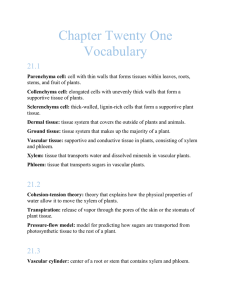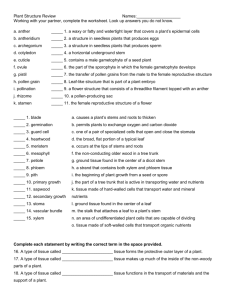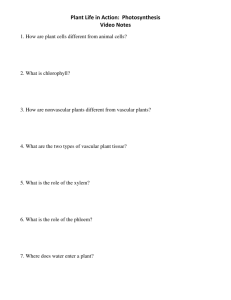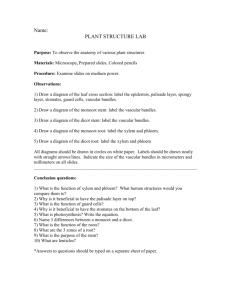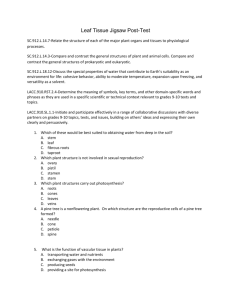Question 2 (1 point)
advertisement
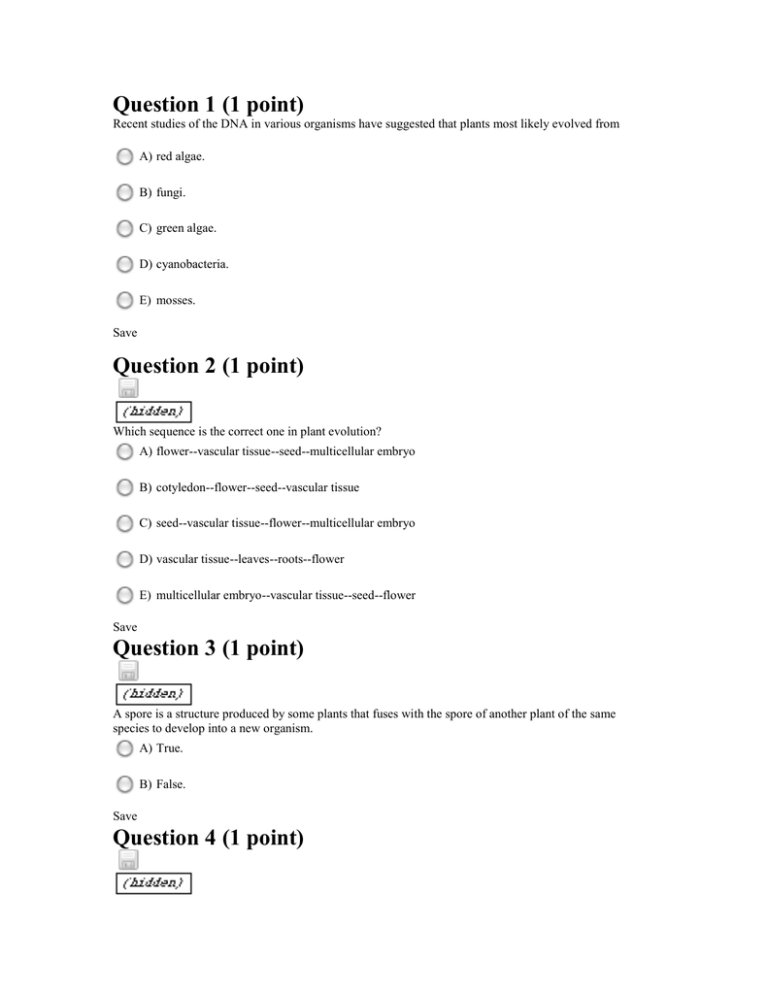
Question 1 (1 point) Recent studies of the DNA in various organisms have suggested that plants most likely evolved from A) red algae. B) fungi. C) green algae. D) cyanobacteria. E) mosses. Save Question 2 (1 point) Which sequence is the correct one in plant evolution? A) flower--vascular tissue--seed--multicellular embryo B) cotyledon--flower--seed--vascular tissue C) seed--vascular tissue--flower--multicellular embryo D) vascular tissue--leaves--roots--flower E) multicellular embryo--vascular tissue--seed--flower Save Question 3 (1 point) A spore is a structure produced by some plants that fuses with the spore of another plant of the same species to develop into a new organism. A) True. B) False. Save Question 4 (1 point) Which of the following is an incorrect association? A) gametophyte--evolves vascular tissue B) angiosperm--flowering plant C) sporophyte--diploid number D) pine tree--gymnosperm E) male gametophyte--pollen grain Save Question 5 (1 point) Bryophytes A) have apical leaves. B) have a root system as long as the stem. C) have a sporophyte as the dominant generation. D) include the liverworts and mosses. E) have vascular tissue in the stem only. Save Question 6 (1 point) Irish moss is a moss found only in regions along the northern sea coasts. A) True. B) False. Save Question 7 (1 point) Which of the following is an incorrect match? A) phloem--conducts water up from roots B) lignin--makes cells in xylem strong C) fern--vascular plant D) xylem--carries minerals from roots to leaves E) leaves--stomata Save Question 8 (1 point) A seed contains a/an A) ovule. B) pollen grain. C) sporophyte embryo. D) haploid gamete. E) gymnosperm. Save Question 9 (1 point) No external water is required for fertilization to occur in a seed plant. A) True. B) False. Save Question 10 (1 point) Which of the following is an incorrect match? A) conifers--plants that bear cones B) resin--protects leaves from insects C) angiosperms--thrive in many different habitats D) gymnosperm-naked seeds E) pines-contain mostly phloem Save Question 11 (1 point) Sepals A) always stay attached to the calyx. B) attract pollinators. C) may be colored. D) are part of the ovule. E) elevate the stigma. Save Question 12 (1 point) From which part of a flower is the fruit derived? A) ovary B) style C) calyx D) cotyledon E) zygote Save Question 13 (1 point) Because they photosynthesize, fungi are actually specialized plants. A) True. B) False. Save Question 14 (1 point) A mushroom is actually a A) modified ovule. B) autotroph. C) mycelium. D) fruiting body. E) vascularized stem. Save Question 15 (1 point) Fungi in the genus Tinea cause the widest variety of fungal infections. A) True. B) False. Save Question 16 (1 point) Ferns have sporangia located in clusters called ___________ under their fronds. A) indusia B) spores C) antheridium D) sori E) archegonium Save Question 17 (1 point) Gymnosperms are the most abundant group of plants. A) True B) False Save Question 18 (1 point) Which part of the flower has adapted to attract and adhere pollen? A) corolla B) stigma C) anther D) style E) sepals Save Question 19 (1 point) All of the following are benefits of plants except: A) return organic nutrients to the soil B) used to make furniture C) used to make drugs D) used in making clothing E) food Save Question 20 (1 point) Mycoses are diseases caused by A) viruses. B) bacteria. C) prions. D) fungi. E) protozoans. Chapter 19 Which of the following is not descriptive of animals? A) internal digestion of food B) multicellular C) muscle tissue D) chemoautotroph E) nervous system Save Question 2 (1 point) A hermaphrodite exhibits bilateral symmetry--one half appearing female and one half appearing male. A) True. B) False. Save Question 3 (1 point) Octopuses are highly intelligent. A) True. B) False. Save Question 4 (1 point) Which of the following is not a feature of an insect? A) eight legs B) segmented body C) chitin in the exoskeleton D) penis in the male E) respiratory organs Save Question 5 (1 point) The most numerous and diverse of all the vertebrates are the A) birds. B) bony fishes. C) reptiles. D) amphibians. E) primates. Save Which of the following is not descriptive of animals? A) internal digestion of food B) multicellular C) muscle tissue D) chemoautotroph E) nervous system Save Question 2 (1 point) All animals are thought to have descended from a primitive type of bacterial cell. A) True B) False Save Question 3 (1 point) Which of the following is an incorrect match? A) radial symmetry--animal has definite left and right halves B) cephalization--brain at anterior end C) pseudocoelom--body cavity incompletely lined with mesoderm D) jointed appendages--arthropods E) segmentation--repetition of body parts along the length of the animal Save Question 4 (1 point) A choanocyte is a specialized cell that can be used to defend the sponge. A) True. B) False. Save Question 5 (1 point) Which of the following characteristics is not seen in Planarians? A) bilateral symmetry B) three germ layers C) cephalization D) a ladderlike nervous system E) a cellular level of organization Save Question 6 (1 point) A hermaphrodite exhibits bilateral symmetry--one half appearing female and one half appearing male. A) True. B) False. Save Question 7 (1 point) Which of the following is matched correctly? A) trichinosis--most common parasitic disease in United States B) ascaris--undercooked pork C) elephantiasis--filarial worm D) roundworms--Schistosoma E) hookworm--lodge in heart Save Question 8 (1 point) In deuterostomes, the blastopore becomes the A) anus. B) brain. C) endodermal tissue. D) trachea. E) mouth. Save Question 9 (1 point) Octopuses are highly intelligent. A) True. B) False. Save Question 10 (1 point) Which of the following is not a characteristic of annelids? A) nephridia B) segmented body C) setae D) radial symmetry E) closed circulatory system Save Question 11 (1 point) Which of the following is not a feature of an insect? A) eight legs B) segmented body C) chitin in the exoskeleton D) penis in the male E) respiratory organs Save Question 12 (1 point) Scorpions are the oldest terrestrial arthropods. A) True. B) False. Save Question 13 (1 point) Echinoderms A) are protostomes. B) are all terrestrial. C) are not related to chordates. D) do not have a brain. E) have a complex circulatory system. Save Question 14 (1 point) The most numerous and diverse of all the vertebrates are the A) birds. B) bony fishes. C) reptiles. D) amphibians. E) primates. Save Question 15 (1 point) Reptiles have poorly-developed lungs. A) True. B) False. Save Question 16 (1 point) Which of the following is not a characteristic of all mammals? A) large brain B) nursing of young C) hair D) placenta E) teeth Save Question 17 (1 point) Which of the following is an incorrect association? A) promisians--lorises B) Homo habilis--stone tools C) anthropoids--lemurs D) hominid--bipedalism E) australopithecines--human ancestors Save Question 18 (1 point) The multiregional continuity hypothesis, which proposes that evolution to modern humans was similar in several different places, is the hypothesis best supported by raw data. A) True. B) False. Save Question 19 (1 point) The oldest fossils to be designated Homo sapiens are A) Homo erectus. B) Neandertals. C) Homo habilis. D) Cro-Magnons. E) Australopithecines. Save Question 20 (1 point) All chordates are vertebrates. A) True B) False Save In general, the root system of a plant is twice as long as the shoot system. A) True. B) False. Save Question 2 (1 point) A plant that annually loses its leaves is called A) monocot. B) vascular. C) eudicot. D) perennial. E) deciduous. Save Question 3 (1 point) The phloem A) is involved in water absorption. B) protects the xylem. C) transports organic molecules. D) is found only in the roots. E) produces lignin. Save Question 4 (1 point) The function of the root nodules of legumes is A) storage of carbohydrate. B) house symbiotic bacteria. C) water absorption. D) photosynthesis. E) synthesize meristem. Save Question 5 (1 point) All of the following are micronutrients of plants except: A) manganese B) iron C) copper D) magnesium E) chlorine Save The three vegetative organs of a flowering plant are the A) root, stem, pistil. B) stem, terminal bud, root. C) stem, stamen, carpel. D) leaf, stem, root. E) root, leaf, shoot. Save Question 2 (1 point) In general, the root system of a plant is twice as long as the shoot system. A) True. B) False. Save Question 3 (1 point) Carrot plants store the substances made during photosynthesis in their A) leaves. B) roots. C) nodes. D) terminal buds. E) shoot system. Save Question 4 (1 point) A plant that annually loses its leaves is called A) monocot. B) vascular. C) eudicot. D) perennial. E) deciduous. Save Question 5 (1 point) The main function of the cuticle of a plant is to minimize water loss. A) True. B) False. Save Question 6 (1 point) Which of the following is/are not part of the ground tissue of plants? A) lignin B) collenchyma cells C) tracheid cells D) cellulose fibrils E) plastids Save Question 7 (1 point) The phloem A) is involved in water absorption. B) protects the xylem. C) transports organic molecules. D) is found only in the roots. E) produces lignin. Save Question 8 (1 point) The loosely packed arrangement of cells of the spongy layer of leaves is to provide more space for storage of starch. A) True. B) False. Save Question 9 (1 point) Which statement is not true? A) Xylem is generally toward the outside of a stem, phloem toward the inside. B) Water, carbon dioxide, and oxygen enter and exit leaf at the stomata. C) Sieve-tube members have no nuclei. D) Mesophyll tissue carries on photosynthesis. E) Nonwoody plants always remain herbaceous. Save Question 10 (1 point) A woody eudicot stem has three distinct areas: A) cambium, pith, cork B) cork, bark, pith C) wood, bark, xylem D) phloem, xylem, bark E) pith, wood, bark Save Question 11 (1 point) Summer wood has a lower number of vessels to transport water to leaves. A) True. B) False. Save Question 12 (1 point) Which of the following is an incorrect match regarding the tissues of a eudicot root? A) vascular tissue--xylem B) cortex--starch granules C) pericycle--protection D) endodermisregulate minerals E) epidermis--rectangular cells Save Question 13 (1 point) The function of the root nodules of legumes is A) storage of carbohydrate. B) house symbiotic bacteria. C) water absorption. D) photosynthesis. E) synthesize meristem. Save Question 14 (1 point) The evaporation of water from leaf cells is called A) transpiration. B) adhesion. C) stomatic osmosis. D) cohesion. E) phyllotension. Save Question 15 (1 point) The amount of sunlight striking a leaf determines if stomata open or close. A) True. B) False. Save Question 16 (1 point) All of the following are characteristics of monocots except: A) parallel leaf veins B) flowers in multiples of fours C) one cotyledon D) root xylem and phloem in a ring E) vascular bundles scattered in stem Save Question 17 (1 point) The ___________ attaches a blade of a leaf to the stem. A) mesophyll B) stomata C) tracheids D) pith E) petiole Save Question 18 (1 point) Root hairs are found on all 3 zones of a eudicot root tip. A) True B) False Save Question 19 (1 point) All of the following are micronutrients of plants except: A) manganese B) iron C) copper D) magnesium E) chlorine Save Question 20 (1 point) The cohesion-tension model of transport occurs in phloem. A) True B) False
